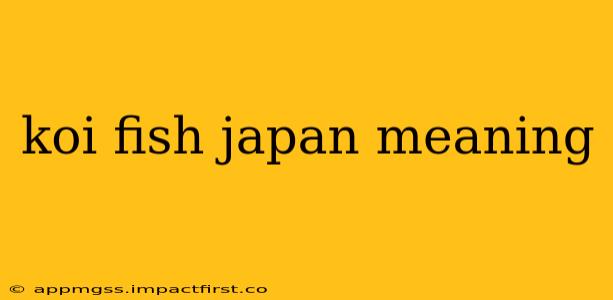Koi fish hold a deeply significant place in Japanese culture, transcending their status as mere ornamental pond dwellers. Their vibrant colors and graceful movements symbolize a wealth of positive attributes, making them a powerful and enduring symbol throughout Japan and beyond. This article will delve into the rich meaning and symbolism of koi fish in Japan, exploring their cultural significance and answering some frequently asked questions.
What do Koi fish symbolize in Japan?
In Japan, koi fish are primarily associated with persistence, courage, and ambition. The legendary story of koi fish swimming upstream against strong currents to reach the Dragon Gate and transform into dragons cemented this symbolism. This arduous journey represents the overcoming of obstacles and the pursuit of one's goals, no matter how challenging. Different colors of koi further enhance their symbolic meaning:
- Black (Kuro): Overcoming difficulties, strength, and perseverance.
- Red (Aka): Love, passion, courage, and joy.
- White (Shiro): Purity, innocence, and perfection.
- Blue (Ai): Fertility, growth, and abundance.
- Yellow (Ki): Wealth, prosperity, and good fortune.
- Orange (Hi): Ambition, enthusiasm, and creativity.
The combination of colors adds layers of meaning, making each koi a unique representation of specific aspirations and qualities.
What is the legend of the Koi fish?
The most well-known legend surrounding koi fish is that of the Dragon Gate. This legend tells of koi fish swimming relentlessly upstream against powerful currents, ultimately reaching the Dragon Gate waterfall. Those koi that successfully reach the top are said to transform into powerful dragons. This story is a potent metaphor for perseverance and the transformative power of achieving one's goals. The legend reinforces the association of koi with ambition, strength, and the triumph over adversity.
What does a Koi pond symbolize?
A koi pond in a Japanese garden is more than just a decorative feature; it's a living representation of the ideals embodied by the koi themselves. It symbolizes harmony, balance, and the pursuit of enlightenment. The careful tending of the pond and its inhabitants reflects the dedication and patience required to achieve personal growth and overcome challenges, mirroring the koi's journey to the Dragon Gate. The serenity of the pond itself is also a reflection of inner peace and tranquility.
Are Koi fish good luck?
Yes, in Japanese culture, koi fish are widely considered symbols of good luck and prosperity. Their association with perseverance and the achievement of goals makes them a powerful talisman for success. Gifting koi or koi-themed art is considered auspicious, signifying wishes for good fortune and overcoming life's challenges. The vibrant colors and graceful movements of the fish are also aesthetically pleasing, contributing to their positive associations.
What is the difference between Koi and goldfish?
While both are members of the Cyprinidae family, koi and goldfish are distinct species. Koi ( Cyprinus carpio ) are a domesticated variety of the common carp, bred specifically for their size, color, and longevity. Goldfish, while sharing some common ancestry, are a separate species with different genetic characteristics, typically smaller in size and with a shorter lifespan. Koi are prized for their larger size and intricate color patterns, and this is a major differentiating factor.
How are Koi fish used in Japanese art?
Koi fish are frequently depicted in Japanese art, appearing in paintings, pottery, and woodblock prints. Their vibrant colors and symbolic meanings make them a popular subject, often used to convey messages of perseverance, good fortune, and the beauty of nature. These artistic representations further solidify the fish's cultural significance and contribute to their enduring popularity.
By understanding the multifaceted symbolism and rich history of the koi fish in Japan, we can appreciate their significance far beyond their aesthetic beauty. They stand as a powerful reminder of the importance of perseverance, the beauty of achieving one's goals, and the enduring power of hope.
